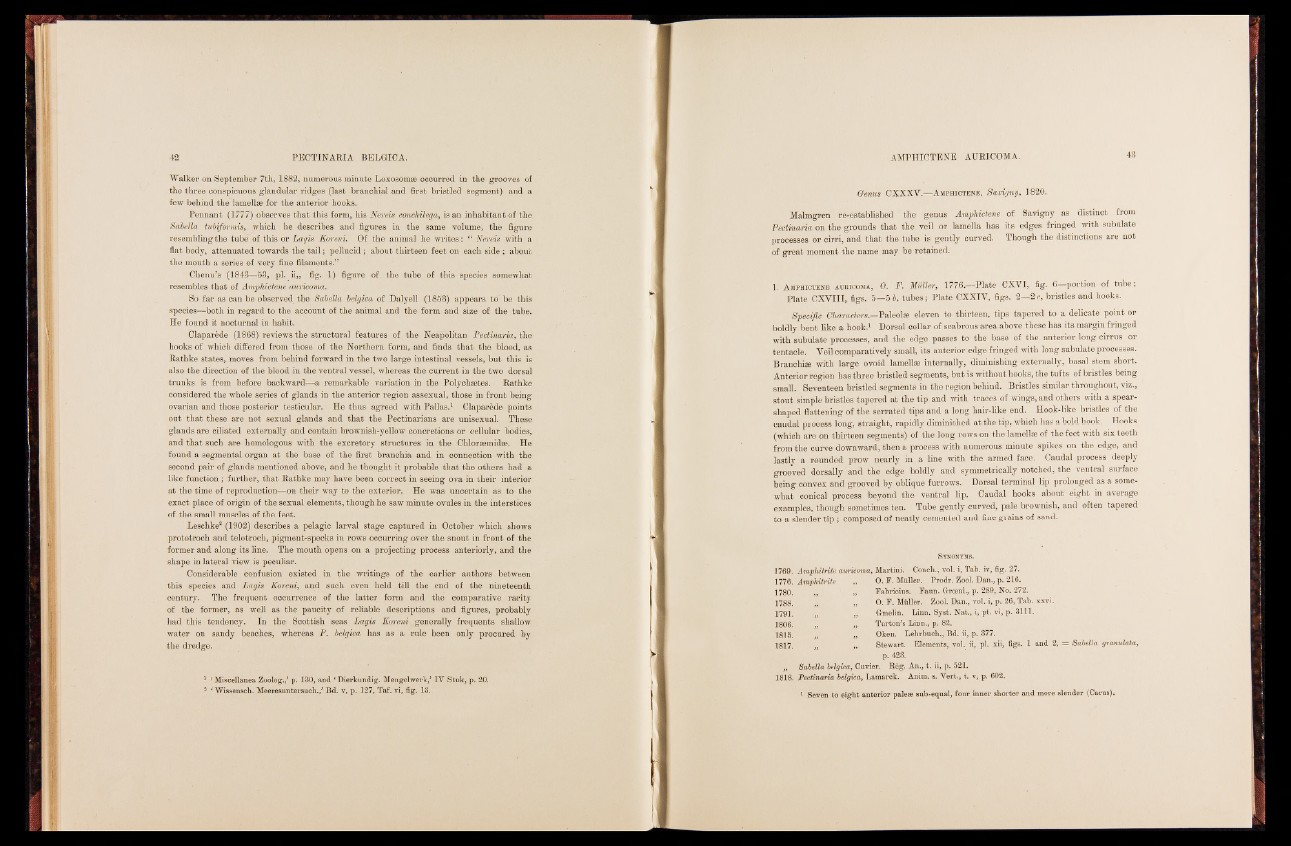
Walker on September 7th, 1882, numerous minute Loxosomæ occurred in the grooves of
the three conspicuous glandular ridges (last branchial and first bristled segment) and a
few behind the lamellæ for the anterior hooks.
Pennant (1777) observes that this form, his Nereis conchilega, is an inhabitant of the
Sabella tubiformis,. which he describes and figures in the same volume, the figure
resembling the tube of this or Lagis Koreni. Of the animal he writes : “ Nereis with a
flat body, attenuated towards the tail ; pellucid ; about thirteen feet on each side ; about
the mouth a series of very fine filaments;”
Chenu’s (1843—58, pi. ii„ fig. 1) figure of the tube of this species somewhat
resembles that of Amphict&iie auricoma.
So far as can be observed the Sabella belgica of Daly ell (1858) appéars to be this
species—both in regard to the account of the animal and the form and size of the tube.
He found it nocturnal in habit.
Claparède (1868) reviews the structural features of the Neapolitan Pectinaria, the
hooks of which differed from those of the Northern form, and finds that the blood, as
Rathke states, moves from behind forward in the two large intestinal vessels, but this is
also the direction of the blood in the ventral vessel, whereas the current in the two dorsal
trunks is from before backward—a remarkable variation in the Polychætes. Rathke
considered the whole series of glands in the anterior region assexual, those in front being
ovarian and those posterior testicular. He thus agreed with Pallas.1 Claparède points
out that these are not sexual glands and that the Pectinarians are unisexual. These
glands are ciliated externally and contain brownish-yellow concretions or cellular bodies,
and that such are homologous with the excretory structures in the Chloræmidæ. He
found a segmental organ at the base of the first branchia-and in connection with the
second pair of glands mentioned above, and he thought it probable that the others had a
like function ; further, that Rathke may have been correct in seeing ova in their interior
at the time of reproduction—on their way to the exterior. He was uncertain as to the
exact place of origin of the sexual elements, though he saw minute ovules in the interstices
of the small muscles of the feet.
Leschke2 (1902) describes a pelagic larval stage captured in October which shows
prototroch and telotroch, pigment-specks in rows occurring over the snout in front of the
former and along its line. The mouth opens on a projecting process anteriorly, and the
shape in lateral view is peculiar.
Considerable confusion existed in the writings of the earlier authors between
this species and Lagis Koreni, and such even held till the end of the nineteenth
century. The frequent occurrence of the latter form and the comparative rarity
of the former, as well as the paucity of reliable descriptions and figures, probably
had this tendency. In the Scottish seas Lagis Koreni generally frequents shallow
water on sandy beaches, whereas P. belgica has as a rule been only procured by
the dredge.
1 ■ Miscellanea Zoolog./ p. 130, and ‘ Dierkundig. Mengelwerk/ IV Stuk, p. 20.
3 ‘ Wissensch. Meeresuntersuch./ Bd. v, p. 127, Taf. vi, fig. 13.
Genus CXXXV.—Amphictene, Savigny, 1820.
Malmgren re-established the genus Amphictene of Savigny as distinct from
Pectinaria on the grounds that the veil or lamella has its edges fringed with subulate
processes or cirri, and that the tube is gently curved. Though the distinctions are not
of great moment the name may be retained.
1. Amphictene auricoma, 0. F. Mull&)', 1776.—Plate CXVI, fig. 6 portion of tube;
Plate CXVIII, figs. 5—5 6, tubes; Plate CXXIV, figs. 2—2c, bristles and hooks.
Specific Characters.—Paleolse eleven to thirteen, tips tapered to a delicate point or
boldly bent like a hook.1 Dorsal collar of scabrous area above these has its margin fringed
with subulate processes, and the edge passes to the base of the anterior long cirrus or
tentacle. Veil comparatively small, its anterior edge fringed with long subulate processes.
Branchiee with large ovoid lamellae internally, diminishing externally, basal stem short.
Anterior region has three bristled segments, but is without hooks, the tufts of bristles being
small. Seventeen bristled segments in the region behind. Bristles similar throughout, viz.,
stout simple bristles tapered at the tip and with traces of wings, and others with a spear-
shaped flattening of the serrated tips and a long hair-like end. Hook-like bristles of the
caudal process long, straight, rapidly diminished at the tip, which has a bold hook. Hooks
(which are on thirteen segments) of the long rows on the lamella? of the feet with six teeth
from the curve downward, then a process with numerous minute spikes on the edge, and
lastly a rounded prow nearly in a line with the armed face. Caudal process deeply
grooved dorsally and the edge boldly and symmetrically notched, the ventral surface
being convex and grooved by oblique furrows. Dorsal terminal lip prolonged as a somewhat
conical process beyond the ventral lip. Caudal hooks about eight in average
examples, though sometimes ten. Tube gently curved, pale brownish, and often tapered
to a slender tip ; composed of neatly cemented and fine grains of sand.
1769.
1776.
1780.
1788.
1791.
1806.
1815.
1817.
Synonyms.
Amphitrite auricoma, Martini. Conch., vol. i, Tab. iv, fig. 27.
Amphitrite „ O. F. Müller. Prodr. Zool. Dan., p. 216.
}> „ Fabricius. Faun. G-roenl., p. 289, No. 272.
}) O. F. Müller. Zool. Dan., vol. i, p. 26, Tab. xxvi.
I }) Grmelin. Linn. Syst. Nat., i, pt. vi, p. 3.111.
J} J} Turton’s Linn., p. 82.
)} „ Oken. Lehrbuch., Bd. ii, p. 377.
„ Stewart. Elements, vol. ii, pi. ,xii, figs. 1 and 2, = Sabella granulata,
p. 423.
Sabella belgica, Cuvier. Règ. An., t. ii, p. 521.
Pectinaria belgica, Lamarck. Anim. s. Vert., t. v, p. 602.
1 Seven to eight anterior palese sub-equal, four inner shorter and more slender (Carus).